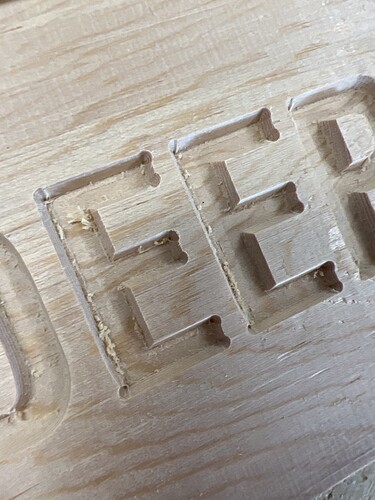With all V-carving, if that last step were removed from the process, the final result would only have rounded corner edges on all the letter shapes instead of sharp corners. That last step, and in fact everything related to V-carving depends very much on a careful, accurate probing so that the machine knows exactly where the top of the material is, and it also depends on the material being very flat, and the machine being trammed properly to the material.
This can also occur if steps per mm in Z is incorrect. When trying to cut the diagonal upward cuts to produce the sharp corners, if the Z does not raise enough, then it leaves those dog bone shapes.
Double check that movement in Z is moving the right amount. E.g. touch the surface, then command a +50 mm Z movement, and measure how high the tool has actually moved.
That is only if you can assert that the shaft is perpendicular to the measuring device. My point being that assaying parallel to the shaft is easier. It is the accuracy of the measurement that I question more than anything else. Sorry if that wasn’t clear.
Personally, I would not trust myself to hold a 1/4" shaft absolutely parallel to a surface, and would find a 1° variance not unusual at all.
As to the effect of 1° variance in the angle, it wouldn’t create those mouse ears at the corners, I think. The sin of 1° is about 0.0175 so an error if 1° about 10mm away from the apex would result in an error of 0.175mm, which in absolute terms is negligible. Just for comparison, a piece of masking tape is about this thick. This is more in the category of “leaves ridges that can be felt with a fingernail” than the error that we’re seeing here. In any case, even if the measurement is perfectly accurate, I don’t think it’s responsible for the carving error.
I think Jamie’s suggestion of ensuring accurate Z is a good one.
Also, try it in a softer material, like pink foamboard. It makes a mess, but rules out tool deflection and other errors, and is also an inexpensive way to test cuts.
What I’m seeing looks like a Z only move in the corners, i.e. a drilled cone shape instead of a 2.5D/X,Y,Z sloping V shape.
